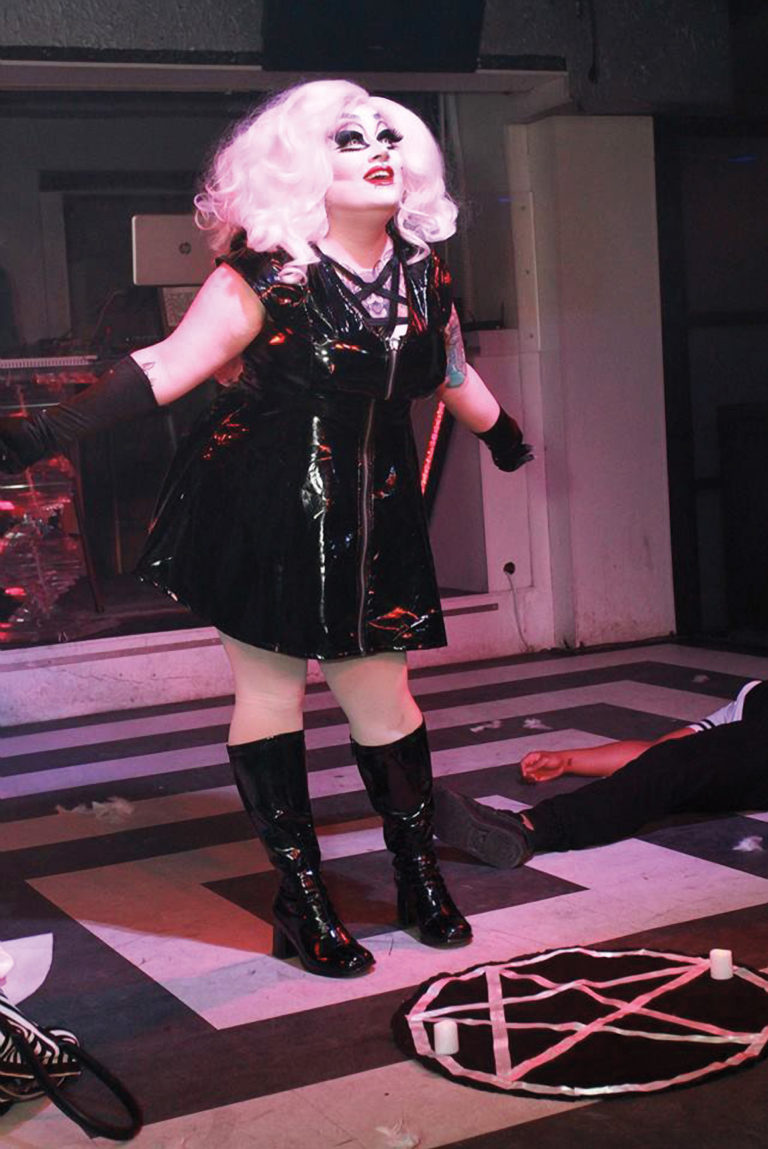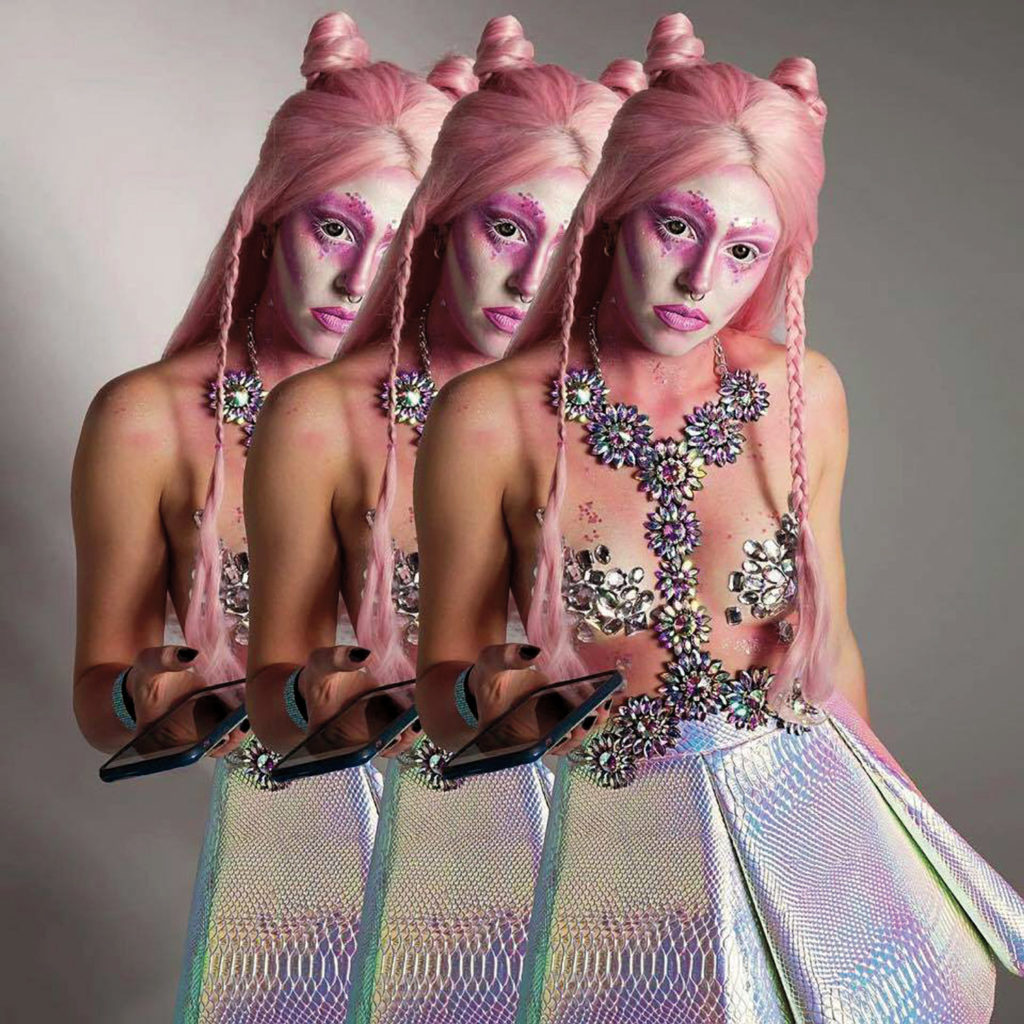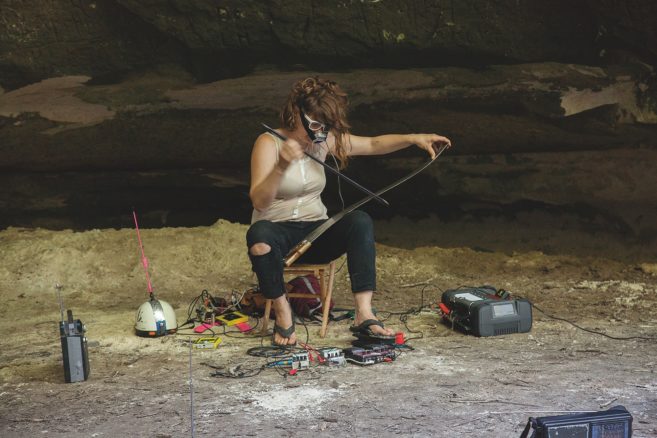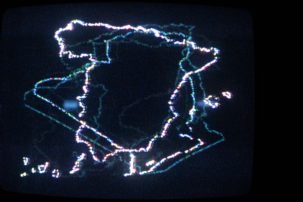Like most queer youth of her generation, Lisa Morrison’s first introduction to drag was watching RuPaul’s Drag Race. With her background in acting, dancing and costume-making, Morrison thought she would be a great drag queen—if only she were a man. Until that point, she had seen only cisgender men on Drag Race. Her curiosity finally got the best of her one day, and she turned to Google to find out if other people could be drag queens too. To her surprise, a bunch of examples popped up.
She began experimenting with drag almost immediately, and made her debut as Lizzy Strange in January 2016. As someone who was assigned female at birth (AFAB), Morrison says that doing drag has encouraged her to think more critically about how she expresses her gender. “Lizzy has always been this über feminine, über girly character that I love to play with, but at the same time she’s very different from my everyday life as Lisa,” she says. “I don’t wear makeup day to day…I have short hair, and I dress how I feel—whether it’s a button-up or a skirt.”
At the time, Morrison says she was one of only a couple AFAB drag queens in Halifax. Although she had many supporters in the local queer community, there were also older performers who weren’t sure about what she was doing or if they would consider it drag, despite examples of AFAB performers contributing to drag scenes around the world, and evidence of such performances dating back to as early as the 1700s.
In my interviews with drag performers across the country, I have repeatedly had drag described to me as an “inherently queer art form.” The history of drag is inextricable from the history of queer communities. Marsha P. Johnson and Sylvia Rivera, trans activists who were famously involved in the 1969 Stonewall Riots that sparked the modern LGBTQ rights movement, were both drag queens. Over time, drag performers have become some of the most visible spokespeople of queer communities.
Morrison’s story is similar to those of many other young women and AFAB performers who have been drawn to drag. Despite a long history that has involved people of all genders, in recent years drag has come to signify a particular performance of femininity by cisgender gay men. Women, trans and non-binary people have been all but erased from mainstream drag culture. Just last year, in an interview for the Guardian, show host RuPaul said he would “probably not” let AFAB people or trans women who have had gender confirmation surgery compete on Drag Race. RuPaul later apologized in the wake of intense criticism, and allowed trans drag queen Gia Gunn to compete on the fourth season of Drag Race All Stars (although she has since accused the show of editing out a confrontation between her and RuPaul about anti-trans discrimination).
But comments like this, from the drag world’s most prominent spokesperson, aren’t stopping a new generation of AFAB drag queens and “genderfuck” performers from carving out spaces in their local drag scenes. There has been a resurgence of AFAB performers across Canada, many of whom are pushing the art form in exciting and provocative directions.
 Sapphoria performing “My Heart Belongs to Daddy” at Alberta's Next Drag Superstar (2019). Photo: Kurtis Allan.
Sapphoria performing “My Heart Belongs to Daddy” at Alberta's Next Drag Superstar (2019). Photo: Kurtis Allan.
Enter Sapphoria, the self-described “dumb bimbo super Catholic girl who falls in love with the devil via a possessed vibrator.” Out of drag, the Edmonton queen is Levi Osler, a trans man who started doing drag in early 2018. Despite being relatively new to the drag world, Osler is a polished performer: Sapphoria’s makeup is expressive and refined (thanks to Osler being a trained aesthetician and makeup artist); her numbers are engaging and expertly rehearsed, and often include a pointed critique of the expectations of femininity.
Take for example Sapphoria’s performance in March 2019, during the second preliminary round for Alberta’s Next Drag Superstar competition, where she lip-synched to Eartha Kitt’s recording of the famous 1938 Cole Porter song “My Heart Belongs to Daddy.” She came out wearing a white dress and seduced a man from the audience onto the stage. About a minute into the seduction, she pulled out a plastic dagger and pretended to kill the man before pulling out a piece of cloth with an inverted pentagram—one of Satanism’s most recognizable symbols—that she placed carefully onto the floor. The music then abruptly changed to the song “Year Zero” by Swedish doom-metal band Ghost, and Sapphoria stripped off her white dress to reveal a black dominatrix-style outfit.
For Osler, drag has been intimately linked with his exploration of gender. Before doing drag, he says he identified as non-binary for several years, and he still describes his presentation as “femme.” He says that doing drag has helped affirm his masculinity. “Sapphoria is a character I portray, and I can take her off at the end of the day,” he says. “It’s not who I am in real life. It’s just something that’s fun to play around with.”
“Sometimes I have numbers about being trans, but for the most part it’s just dumb, campy, Satanic masturbation stuff,” Osler says. He says that when AFAB performers do femme drag it has the potential to be subversive in a different way than when assigned male at birth (AMAB) performers do. “It’s maybe more self-aware,” he says, adding that AMAB drag sometimes essentializes particular traits of femininity.
In December 2018, Osler co-hosted a showcase of trans and non-binary drag artists to provide space in the Edmonton drag scene for performers who don’t see themselves represented in the mainstream drag world. The Trans and Non-Binary Revue, which had its second event this spring, is just one example of many shows popping up across Canada that cater to drag performers who have been pushed to the margins. In Winnipeg, a group called Slunt Factory has been hosting a monthly showcase of new drag talent since last October. All three of the group’s founders are AFAB, and the shows have contributed to an influx of AFAB drag queens entering the Winnipeg scene.
“I think it’s been a ripple effect of people realizing that this is an open door,” says Moxie Cotton, one of Slunt Factory’s co-founders. “We’ve welcomed a whole group of people who didn’t realize they could do drag before.” Out of drag, Moxie Cotton is Caity Maskiew, who identifies as agender. When they began performing nearly two years ago, Maskiew didn’t see anyone else in the city doing femme-presenting drag who looked like them. Now, Maskiew knows of at least half a dozen AFAB drag queens in the city—with that number growing at nearly every Slunt Factory show.
“Women and AFAB people have been doing drag for all of history. People just don’t realize that because there’s been so much queer femme erasure.”
Although Maskiew says the local drag community has been overwhelmingly accepting of them and other AFAB performers, they have encountered some pushback from other members of the local queer community. In particular, they say that cisgender gay men often act as though they own the city’s queer spaces. They describe how men have come up to them after shows to question the right of AFAB performers to take up space in the city’s drag scene. “It’s exhausting,” Maskiew says about those moments.
“I’m here after a really great show to drink and have fun with my friends, to talk and be part of this community. And you’re coming here and attacking my right to exist in this space? I don’t think so.” Slunt Factory co-founder Stara David has had similar experiences: “Part of being an AFAB performer is that there’s so much emotional labour that goes along with it,” they say. Out of drag, Stara is Ezi Raizen, a local theatre student who identifies as non-binary. They say they’re frustrated by the assumption made by many people that AFAB drag queens are straight women. “People refuse to acknowledge that queer women exist,” Raizen says. “It makes me angry!”
This kind of discrimination against AFAB drag performers isn’t limited to smaller drag scenes such as Winnipeg’s—it’s prevalent in the country’s biggest scenes too. Although she’s travelled around the world in drag, Courtney Conquers says the worst place she’s faced backlash for being an AFAB drag queen is at home in Toronto. And while she acknowledges that the Toronto scene is slowly getting better for those who aren’t cisgender, gay and male, Conquers says she’s been harassed for being a drag queen, and that there are still comparatively few opportunities for AFAB performers. She says that many have forgotten the long history of people assigned female at birth doing drag.
“Women and AFAB people have been doing drag for all of history,” Courtney Conquers says. “People just don’t realize that because there’s been so much queer femme erasure. We were called drag queens and people assumed that we were men, or we were called Vegas showgirls but what we were really doing was drag, or we were called burlesque dancers but we were actually with the drag queens and not the dancers.”
Along with fellow AFAB drag queen Ja’mie Queen West, Conquers is one of the people behind Drag Coven, a group that travels to cities around the world documenting different drag scenes and performers. Through Drag Coven she’s met countless performers, and she says that in her conversations with older queens, she’s heard time and again about women and AFAB people doing drag long before this latest surge of performers.
What’s to blame for the erasure of queer femme voices in drag history? In a single word: misogyny. “But I think it’s a little more specialized than that,” Conquers adds. “It’s not just the wider systems of normative misogyny. That may be where it’s rooted, but it’s also queer misogyny. It’s misogyny rooted within the drag community, within the queer community.”
About a year and a half ago, after starting drag in Halifax, Lisa Morrison moved to Montreal. There, she encountered dynamics similar to what AFAB drag queens in other cities describe. “I’ve definitely been in spaces where I don’t feel as comfortable as I think I should in a community that preaches acceptance for everyone,” she says. She’s now the co-producer of a show in Montreal called Alternadrag, which provides a platform for BIPOC, queer and trans performers who don’t have spaces in the mainstream drag community—and some of the people taking the stage at those shows are AFAB drag queens.
At the same time as more and more AFAB performers are making waves in their local drag scenes, the mainstream art world is also beginning to recognize drag as an art form. The crossover of these worlds is playing out in exciting ways.
Alternadrag shows also give performers opportunities to try out more experimental or political numbers, and works to acknowledge shifting conversations around inclusivity. At a recent show, Morrison, who identifies as genderfluid, performed a lip-synch to Beyonce’s 2008 song “If I Were a Boy.” She started the song dressed as Lizzy Strange, in a big gown and long hair, with the word “FEMME” projected on the screen behind her. Partway through the song she stripped off the dress and removed the long wig to reveal Strange’s drag-king alter ego, and the word on the screen changed to “HOMME.” At the end of the song, she shed the button-up shirt and pants to reveal a black bodysuit. She then wiped off all her makeup and took off her final wig, and the word on the screen changed to “FLUIDE.” “It was this moment of acknowledging that this is femme-presenting, this is masc-presenting, and that this is how I see myself,” Morrison explains. “It’s kind of a blank slate and I can do whatever the heck I want with it, because gender is fluid and I can make up what I want for that.”
Despite having to work hard to carve out spaces for themselves, AFAB drag performers are having an undeniable influence in their local drag scenes. “Some of the best drag I’ve ever seen is from AFAB people,” Raizen says. “We have to put in so much more work and effort just to be seen as drag performers or to be seen anywhere near being equal. I think that forces us to put a lot of effort in and be creative with our stuff.”
At a Winnipeg performance last fall, in a showcase called Genderplay Cabaret, Stara David burst onto the stage, with her face painted ghost-white and wearing a knee-length coat and a bowler hat, lip-synching to Rudy Vallée’s 1934 song “You Oughta Be in Pictures.” A minute into the song, she tore off the coat to reveal a tight black leather jacket and black pants before diving into an emotional lip-synch to Billie Eilish’s “When the Party’s Over.” Maskiew was in the audience for that performance, and says it was among the best they’d ever seen.“[Stara] made me cry in the fucking club,” they say. “I yelled, ‘This is art!’ and then the bro standing beside me with the beer in his hand was like, ‘This is art, you’re right!’”
At the same time as more and more AFAB performers are making waves in their local drag scenes, the mainstream art world is also beginning to recognize drag as an art form. The crossover of these worlds is playing out in exciting ways. One of the most high-profile examples is the work of Toronto-born, London, UK–based drag artist Victoria Sin. In 2018 their performance The sky as an image, an image as a net—which has been described as a “ballad of embodiment, longing and transformation”—was included in the Serpentine Galleries’ Park Nights series of experimental art, and a selection of their works was exhibited at Sotheby’s, in London.
“Drag is one of the oldest forms of theatre, but it’s not really recognized as theatre or as high art, because it is kind of low-brow. It is for the common people, but I love it and it can be super elevated and it can range in so many different ways. There’s such a spectrum of what drag can be,” says Vancouver drag artist Rose Butch. Out of drag, Rose Butch is Rae Takei, who says they started doing drag at a point in their life when they were frustrated by what was expected of them in the mainstream professional theatre community. “I went to theatre school to be an actor, and I was told that wasn’t really a thing I could do because I was non-binary,” they say.
Like Takei, Rose Butch is non-binary, and incorporates elements more closely associated with drag kings—such as masculine contouring—into their drag while also embracing femme elements. “I’ve been performing in drag for the last five years, and within that time my drag persona has really helped me grow as an individual, and has helped me in my own personal journey so much,” Takei says. “A big part of that is embracing femme and finding strength in femme.”
Since 2018 Takei has been putting on shows in Vancouver as part of The Darlings, a collective of non-binary drag performers. They say the collective formed with the intention of doing drag in spaces outside queer bars and clubs, where performers could experiment and be, as they put it, a “little bit weird.” The collective’s performances have incorporated dance, poetry, digital elements and other types of performance art.
“There is something really powerful in seeing yourself on stage, and seeing yourself in a way that is not a joke or a side character or a lesson,” Takei says. “Part of what AFAB drag performers are bringing to the conversation is one representation of one facet of the queer community that deserves to be seen, that deserves to have space, and deserves to be cherished.”

 Courtney Conquers. Photo: Matt Burgett.
Courtney Conquers. Photo: Matt Burgett.







